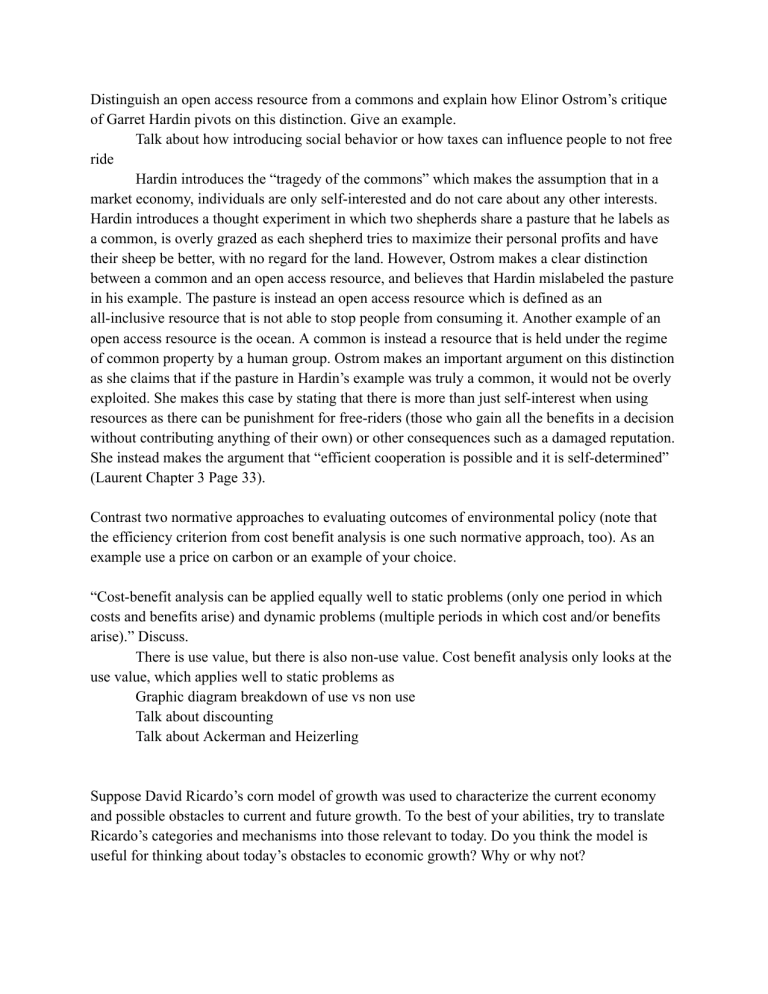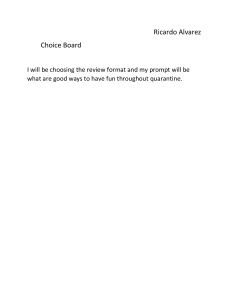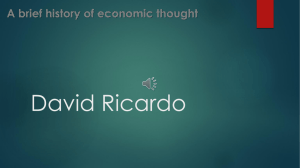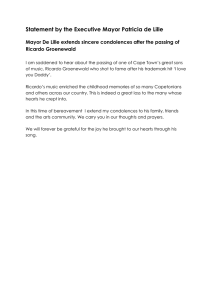
Distinguish an open access resource from a commons and explain how Elinor Ostrom’s critique of Garret Hardin pivots on this distinction. Give an example. Talk about how introducing social behavior or how taxes can influence people to not free ride Hardin introduces the “tragedy of the commons” which makes the assumption that in a market economy, individuals are only self-interested and do not care about any other interests. Hardin introduces a thought experiment in which two shepherds share a pasture that he labels as a common, is overly grazed as each shepherd tries to maximize their personal profits and have their sheep be better, with no regard for the land. However, Ostrom makes a clear distinction between a common and an open access resource, and believes that Hardin mislabeled the pasture in his example. The pasture is instead an open access resource which is defined as an all-inclusive resource that is not able to stop people from consuming it. Another example of an open access resource is the ocean. A common is instead a resource that is held under the regime of common property by a human group. Ostrom makes an important argument on this distinction as she claims that if the pasture in Hardin’s example was truly a common, it would not be overly exploited. She makes this case by stating that there is more than just self-interest when using resources as there can be punishment for free-riders (those who gain all the benefits in a decision without contributing anything of their own) or other consequences such as a damaged reputation. She instead makes the argument that “efficient cooperation is possible and it is self-determined” (Laurent Chapter 3 Page 33). Contrast two normative approaches to evaluating outcomes of environmental policy (note that the efficiency criterion from cost benefit analysis is one such normative approach, too). As an example use a price on carbon or an example of your choice. “Cost-benefit analysis can be applied equally well to static problems (only one period in which costs and benefits arise) and dynamic problems (multiple periods in which cost and/or benefits arise).” Discuss. There is use value, but there is also non-use value. Cost benefit analysis only looks at the use value, which applies well to static problems as Graphic diagram breakdown of use vs non use Talk about discounting Talk about Ackerman and Heizerling Suppose David Ricardo’s corn model of growth was used to characterize the current economy and possible obstacles to current and future growth. To the best of your abilities, try to translate Ricardo’s categories and mechanisms into those relevant to today. Do you think the model is useful for thinking about today’s obstacles to economic growth? Why or why not? David Ricardo was an economist who was heavily influenced by Mathus and his model of economic growth in relation to human population growth. However, Ricardo’s model focuses on agricultural rent. In his corn model of growth, there are three factors that are determined during production of corn: wages, profits, and rent. Ricardo makes many assumptions in his model, one of which wages for workers are set at a level that is subsistence. He assumes that the most fertile lands are first used in production, however, when demand increases past the production capability, less fertile lands are then used. This leads to lower productivity on these lands and his theory of “diminishing returns” as the less productive lands lead to a higher unit cost of production and a higher selling price of the units. Thus there is a “differential rent” since some landowners own a more productive and fertile land and can produce more from these lands. In his model, there is a decline of output and eventually the production from the land does not even cover the cost of the wages themselves. This is the “stationary state” where no profits are made and there is no room for economic growth. However, even Ricardo believed that globalization (trade with other markets) and new technologies could be solutions to the law of diminishing returns. I think Ricardo’s model can be applied to our world today to a certain extent. I think of the United State’s affinity for using fossil fuels for economic growth, as it is one of the cheapest fuel sources. However, since the United States does not have that much oil, we have turned to “less fertile lands” (offshore drilling which isn’t actually less fertile it is just more expensive to produce). However, since oil is not plentiful and instead is a finite resource, there is this “diminishing return” that Ricardo points out and eventually the economy will reach a stationary state. Even his solutions have been applied, as the United States imports much of its oil and there has been a large push for new technologies such as renewable energy sources to replace oil consumption. So although the application is not perfect, I think some aspects are relevant. The most useful part of Ricardo’s model is that the most fertile lands are used first, as this can apply to the cheapest option: the cheapest labor, the cheapest fuel source, etc. This is important when looking at developing countries, such as India, as now with the climate crisis there is a call to not use fossil fuels, yet this is the “best and quickest way” to develop a country— it just is not a sustainable way. I think this way of thinking in Ricardo’s model is very important when analyzing the modern world. However, many current economists are not pushing for unsustainable growth. Jayant Singah, an economist and former parliament member of India, gave a talk at UMass which discussed sustainable development for India, that strayed from Ricardo’s model and instead thought that green technology would be even better for quick development.


